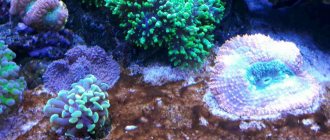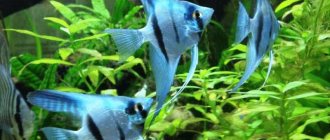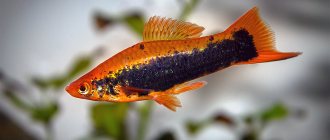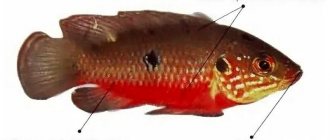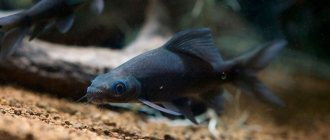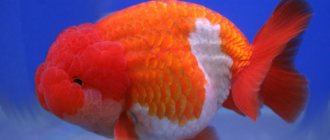5
(25)
Otocinclus is a species of catfish that is distinguished by its small size but great utility. Fish are famous for their ability to eat algae in the aquarium. They can clear any surface of harmful vegetation, even young shoots, without damaging them. Adding otocinclus catfish to your “bank” is a good way to quickly and effectively deal with any algal pests.
General information
These fish are usually bred for their appearance. But Takashi Amano and other experienced aquarists also purposefully use otocinclus to clean the aquarium of unwanted algae. If algae is getting out of control in your aquarium, catfish will work wonders to quickly bring the ecosystem back into balance. We are talking specifically about microalgae that appear in the water column and on the walls of the aquarium. The otik does not eat aquatic plants, using them as a shelter.
Clearing the surface of algae, otocinclus attaches to it using sticky lips. In addition to oxygen dissolved in water, they sometimes need atmospheric air, for which they rise to the surface from time to time.
You don't need a lot of experience to keep otocinclus, as they are not too picky about their environment. If you can keep your aquarium clean, most species will live for 3-5 years, reaching a length of about 5-6 centimeters.
Habitat in nature
Otocinclus is native to South America.
Their main habitats are the rivers of Northern Argentina and Venezuela. However, they are not found in the largest river, the Amazon, which flows through the continent. Usually found in small streams or shallow bodies of water. Here they attach themselves to the substrate or rocks in search of algae. Most of their life is spent on the bottom of the river or on the leaves of large aquatic plants. They stay in groups in one area, completely eating the microalgae on it, then move to a new surface rich in food.
Appearance
Otocinclus are great for small aquariums because adults rarely reach 6 centimeters in length. The smallest species (Otocinclus tapirape) grows to approximately 3 centimeters in length. The largest species is Otocinclus flexilis, whose length can exceed 6 centimeters.
The body of the catfish has a simple cylindrical shape, which tapers towards the front and towards the caudal fin. There is a strong mouth on the head, which is used to fix the fish on a hard surface.
On the left is a boy, on the right is a girl.
Representatives of the family Loricariidae differ from many other groups of catfish in that they have rows of “armor” made of durable scales throughout their bodies. This helps them protect themselves from predatory fish and hard substrates.
If you have an otocinclus catfish, how to distinguish a male from a female is an important question. Females are usually larger and brighter. This is most noticeable when viewed from above or below. Males are distinguished by a flap of skin on the pelvic fin and a small contact organ near its base.
When it comes to colors and patterns, one look can be very different from another.
Behavior
Otocinclus catfish usually have a calm nature. These fish will never become aggressive towards other inhabitants of the aquarium.
Due to their small size, they can easily be eaten by predators and are therefore quite shy. To reduce stress in aquarium conditions, an artificial shelter should be built for them.
It is also useful to keep them not alone, but with other representatives of their species (at least 4-6 pieces).
Otocinclus are usually active during daylight hours, but, being frightened, they can switch to a nocturnal feeding mode and hide during the day, which is very inconvenient for aquarists.
Care and maintenance
In their natural habitats, these fish often attach themselves to boulders, gravel, and other river bottom surfaces that contain small algae.
Even though otocinclus can keep their tanks clean by eating algae, it is still important to change the water weekly or at least every two weeks. This helps prevent nitrate and ammonia buildup and maintain a healthy environment for your fish.
Since catfish live primarily on the bottom, choose a sandy type of substrate for your aquarium and avoid rougher surfaces that can damage the fish's skin as they graze on the algae.
Scratches on the surface of a catfish's body can lead to infections and other illnesses, so efforts should be made to ensure the safety of these bottom dwellers. Although they have "armor" on their belly, you shouldn't rely on it.
Properly selected aquarium decorations will serve as refuges for these fish when they are tired or stressed. Large rocks can be used to create cave shelters for your fish to rest in when they need it.
Expert opinion
Sergeev A.N.
Aquarist with 17 years of experience. An employee of an aquatic center where about 100 species of fish live.
Although otocinclus prefer oxygenated water, no special air pumps are required to keep them alive in the aquarium. Standard aquarium pumps and regular lighting are sufficient equipment.
The minimum size of an Otocinclus aquarium should be around 40 liters. This is enough for 4 to 6 catfish to live. If the volume of the aquarium is larger, the number of individuals can be increased.
Description
The body of the fish is evenly elongated from head to tail, covered with a shell, which to some extent protects from enemies. The shell covers the back and sides, leaving the belly unprotected. Body dimensions are up to 5 cm. The mouth is designed in such a way that it is convenient to collect algae without damaging the plants. In addition, the sucker-type mouth helps catfish cope with the current in their natural habitat. The tail and fins are small, the lateral ones are located close to the abdomen.
Types of otocinclus
There are numerous species of Otocinclus catfish. Let's look at some of them, the most popular among aquarists:
Otocinclus affinis Common Otocinclus is golden in color with a black stripe along the body and dark spots, reaching a length of 6 centimeters.
Otocinclus arnoldi Easily confused with the common one, characterized by more pronounced spots.
Otocinclus batmani Having an elongated yellow body with pronounced brown spots.
Otocinclus bororo Characterized by a pale coloration with a distinct longitudinal black stripe.
Otocinclus caxarari With a dark stripe against the lemon-yellow color of the rest of the body.
Otocinclus cocama Zebra-shaped, usually up to 4.5 centimeters long.
Otocinclus flexilis Otocinclus speckled - having a more pronounced spotted structure than all other representatives of the genus.
Otocinclus hasemani With a body colored in grayish shades, with a darker longitudinal line characteristic of most otocinclus.
Otocinclus hoppei With a high dorsal fin and a diamond-shaped spot near the tail.
Otocinclus huaorani With a contrasting arrangement of bright dark spots on an almost white body.
Otocinclus macrospilus Five centimeter - with patterned spots along the entire back.
Otocinclus mariae Maria - completely covered with spots on top.
Otocinclus mimulus With a light brown back and yellowish belly.
Otocinclus mura Solid dark on top.
Otocinclus tapirape C has a characteristically convex back, usually not reaching 3 centimeters in length.
Otocinclus vestitus With a longitudinal pattern over a dark stripe.
Otocinclus xakriaba With interrupted lateral stripe.
Otocinclus negros Completely dark.
Otocinclus mangaba With serrated pectoral fins and a pale belly.
Otocinclus juruenae With transverse stripes concentrated on the back near the tail.
Compatibility
“Otik” is a fish completely devoid of aggressiveness. You should avoid combining these peace-loving creatures with predators and bullies. In addition, keeping catfish with fish that have a mouth large enough to easily swallow otocinclus is not recommended.
Good options for combination:
Gourami
Barbs
Swordtails
Mollies
Angelfish
In addition, aquarium owners can add invertebrates such as some freshwater snails and shrimp. Otocinclus are well compatible with the Cardina japonica shrimp and theodoxus snail, since they remove strong biological pollution resulting from its vital activity.
Otocinclus and amano shrimp paired together will rid you of unwanted algae in your aquarium.
Do not keep otocinclus in the same tank with other catfish - ancistrus. When algae-eating species (sae) combine, competition arises. Neighborhood with obvious aggressors is also not welcome:
- cichlids;
- cockerels;
- labeo;
- predatory piranhas.
Feeding otocinclus
If we seriously consider the question of what to feed, food made from naturally growing algae in the aquarium seems to be a necessary, but clearly not sufficient supply of nutrients for the catfish.
Tropical Green Algae Wafers are recommended in the form of tableted specialized food for herbivorous and bottom-dwelling fish. It contains spirulina, spinach, and several types of seaweed.
These sinking waffles are enriched with alfalfa and wheat germ, as well as plenty of vitamins. Designed for everyday feeding.
Pet stores that sell aquarium fish often sell algae wafers and briquettes. Some vegetables from your table will also do:
Zucchini
Zucchini
Salad
Spinach
Peas
Chop these ingredients into small pieces and add them to the aquarium several times a week to add variety to the menu. Make sure the food source sinks to the bottom.
Any remaining food not eaten within 24 hours should be removed from the aquarium. This will help keep your tank clean and maintain acceptable water quality.
And yet, the favorite food of otocinclus is algae. If the catfish does not eat anything and does not show any signs of illness, then it has enough algae and does not need the food you offer. True, according to experts, each fish should need 60–70 liters of water to fully feed exclusively on algae. Therefore, if you do not have a huge aquarium, you will still have to feed the catfish.
Nutrition
Catfish are algae eaters, and consistently eat the smallest algae, zooplankton and plaque from the walls of the reservoir with their suction cup mouth. However, sometimes such food may not be enough for the growth and development of pets, so the fish are fed with plant foods: finely chopped zucchini, spinach, cucumbers. Vegetables should first be scalded with boiling water to destroy dirt and bacteria. If it is planned to spawn the fish in the near future, then a little protein food is introduced into the diet.
Reproduction and breeding
Eggs spawned by a female otocinclus.
Otocinclus reaches sexual maturity at the age of 7 months. Increasing the water temperature to 28 degrees and increasing the protein content of the food (for example, adding peas) serve as additional stimuli for mating. Males begin to chase females throughout the aquarium. Conditions for breeding must be ideal, which means that the tank must be kept clean. Judging by personal experience and reviews from other aquarists, in the case of Otocinclus affinis, breeding is somewhat easier than in the case of other species.
Spawning
Spawning is usually confined to the summer months, and several spawning events may occur during the season. Males fertilize the eggs, which are laid in small bunches. At one time, the female lays 60–130 eggs; the clutches are usually placed in the corners of the tank or on the lower surfaces of the leaves of aquarium vegetation. Often the aquarist does not even notice that eggs have been laid. He learns about the offspring only a few days after spawning, when fry appear in the water.
Incubator
For spawning, it is better to transplant the fish into a fish tank. A tank with a volume of 40 to 60 liters is quite suitable for them, which will become an incubator for fry. One female is placed with several males. You don’t have to add soil, but in this case, be sure to put several aquatic plants with large leaves in pots. To disinfect the incubator during the breeding season, you need to change 80 percent of the water twice every day.
It is also useful to add a small amount of methylene blue until the water column turns slightly bluish. After the fry hatch, such disinfection procedures should be discontinued. During this period, about a quarter of the water should be changed weekly.
Raising fry
Tiny fry of otik fish.
To prevent unwanted contacts of juvenile catfish with larger fish, it is better to keep them separately from other species. At first, the fry will feed on algae and bacteria found in the water column of the aquarium. It won't take long and they will soon be able to eat the same foods as adults. You can also feed them with egg yolk. It is recommended to start feeding immediately after the yolk sacs disappear.
Quarantine before moving in
Before moving into a formed aquarium, any newly acquired fish must be quarantined . This is done for timely detection of the disease if new individuals are infected, and for prompt treatment in a small volume of the quarantine reservoir.
For quarantine, a small container of 30–40 liters is usually used . It is not necessary to add soil, but it is worth setting up a shelter.
The aquarium is equipped with an aeration system, regular water changes are carried out, a small amount of peat and a weak solution of methylene blue .
Attention! Do not use preparations based on copper, salt, or dissolve insecticides in water: otocinclus does not tolerate these substances.
Diseases
Catfish are not susceptible to any specific diseases, but can suffer from some of the parasitic, bacterial and fungal problems that are common among freshwater fish.
By observing your fish, you can quickly detect disease. Loss of appetite, lack of activity and increased breathing are all signs of the disease. Look for discoloration, spots, and wounds.
The two most common causes of illness are:
- unclean aquarium;
- bad diet.
If you detect a disease, check the tank parameters. This includes temperature, pH, ammonia, nitrites and nitrates. You can then correct settings that have changed for any reason. It is better to disinfect water with methylene blue or potassium permanganate. The latter is recommended to treat plants before placing them in an aquarium with catfish.
Also think about what you feed your fish. Remove any foods from your diet that may not be nutritious.
Expert opinion
Sergeev A.N.
Aquarist with 17 years of experience. An employee of an aquatic center where about 100 species of fish live.
It is best to quarantine sick fish in a separate tank to protect the rest of the school.
Bacterial diseases are often treated with Tetra LifeGuard and JBL ektol fluid according to the accompanying instructions.
Reviews
Veronica T., a beginner aquarist. It cannot be said that otocinclus catfish look impressive in an aquarium, but they will be of interest to those who like to watch the life of their fish. They “work” seriously - they clean the plants, the soil, the glass of the aquarium, the shells of snails, and even try to clean the neighbors in the aquarium.
Dmitry R., experienced aquarist. Otocinclus catfish are secretive creatures. To get a better look at them and count them, you have to turn on the “moonlight” at night. Then the catfish gather in a flock and move fussily. During the day, cleaners mostly sleep, sitting on a snag.
Otocinclus is a beautiful fish in all respects, and keeping it is not particularly difficult. Cleaner catfish have a wonderful temperament, interesting appearance, and their contribution to the cleanliness of the aquarium cannot be overestimated.
Adviсe
- Adaptation, acclimatization and other adaptation processes of catfish will be accelerated if they are placed inside an aquarium in a transparent, insulated tank for a couple of weeks to allow them to get used to their neighbors.
- Any sudden change in the composition of the water can kill the fish. We are talking about sudden temperature changes, as well as a sudden increase or decrease in nitrogen concentration. Even if the parameters are not lethal for catfish, a sudden change in conditions is destructive for them. The transition to new water should be made only gradually and in case of emergency.
- Sometimes a small change in diet will restore the fish's lost appetite. According to the observations of many otocinclus lovers, zucchini is such a stimulant.
- If, on the contrary, the catfish is so hungry that it begins to nibble on aquatic plants, which it usually does not do, then it does not have enough algal food. A good way to provide your pets with their favorite algae and microorganisms is to keep a separate tank of water in the sun, which must be added to the aquarium periodically.
- Otocinclus have spines on their fins, so it is better not to pick them up. In addition, you yourself can damage a small, delicate fish with your hands. If you need to catch, use only a net or fine mesh.
Previous
Pisces Iriaterina Werner: a southern beauty with a gentle disposition
Next
Marine aquariumContent and types of aquarium moray eels
